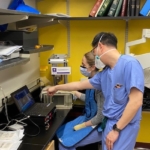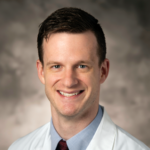By Camille C. Dunn, PhD, CCC-A, Assistant Research Professor, Director, University of Iowa Cochlear Implant Program Department of Otolaryngology—Head and Neck Surgery

Recently, we met with a diverse group of thought leaders to explore best practices for single-sided deafness (SSD)/unilateral hearing loss (UHL). Hear from Dr. Dunn on her experience treating these patients:
What clinical considerations are in your treatment pathway for SSD/UHL Patients?
We consider an array of treatment options such as osseointegrated solutions, CROS hearing technology and a cochlear implant. We have a document that we go over with patients so that they can have an understanding of what each type of technology can and cannot provide for the patient. We do an extensive interview with the patient to understand their hearing history (i.e. duration of loss, etiology), lifestyle, demographic and other medical factors and goals for seeking treatment for their SSD. Based upon this interview, we discuss with the patient which of the treatments would be best or most realistic to help them accomplish their listening goals.
Do you think that the counseling process should include discussion on bone conduction and cochlear implant hearing solutions?
It absolutely should include all of the patient options. If the patient is choosing a cochlear implant, they need to understand that hearing with a CI is a lifelong commitment. Different than someone with bilateral severe-to-profound SNHL, the CI will not ever be their “good ear.” The CI will serve to supplement the normal hearing ear to accomplish spatial hearing abilities. They will have to commit to utilizing the CI effectively by doing listening exercises and wearing the CI all waking hours. As with any type of exercise, consistency is key.
Why is the ability to treat patients with UHL/SSD with cochlear implants important to audiologists, surgeons and patients?
As a medical professional, we are trained to want to provide treatments to our patients. This situation is no different. Patients coming to our clinic who have had gradual progressive hearing loss (maybe even in both ears) for several years have had a chance to accommodate situations with their gradually changing hearing loss. For patients with sudden SSD, they often come to our clinics feeling very debilitated and scared. They suddenly cannot localize sound (or understand speech in adverse listening situations). Imagine hearing your child cry for help and you have no idea where to look for your child to provide them help because you cannot localize where the sound is coming from? Imagine working in a warehouse and all of a sudden you have no idea which direction the beeping is coming from warning you that there is a forklift nearby? All of these situations are life-altering for individuals with SSD. When you let that patient know that there is an option to restore hearing to the deafened ear, you can immediately see a level of calm come over these patients.
What would you tell a provider that is hesitant to explore CI as a treatment option for UHL/SSD?
I would tell them that there is good reason to be hesitant. When we first started implanting patients with SSD I thought that we were crazy! I thought that there was no way that a person with normal hearing would want to listen to the sound from a CI in their deafened ear. I was wrong. I would also tell them that counseling these patients and preparing them for a CI is a bit different than what we used to call our traditional CI patients (because what is traditional these days?). Testing these patients for progression and benefit from their CI is a bit different than listeners with standard bilateral SNHL. I would recommend reaching out their cochlear implant representatives to ask them to guide them through the initial processes of providing care and counseling to these patients so that their patients can have successful outcomes.
Tell us about your experience at the SSD Thought Leader Meeting and what that means for the industry?
The SSD Thought Leader Meeting provided a dynamic avenue for professionals to come together and discuss their experience working with individuals with SSD who get a CI. I believe that together we accomplished a lot. We all came together to develop a consensus on the best way to, not only better understand the benefits of CI for SSD, but treat, counsel and better understand the needs of these patients. They are different than other listeners who have traditionally gotten a CI and because of that, they need to have their own platform of care.
Hear more from another Thought Leader Meeting attendee, Andrea Overton, AuD, and check out our recent FDA approval for CI for SSD.
Camille Dunn, PhD, joined the Department of Otolaryngology—Head and Neck Surgery at the University of Iowa in 2003 where she is an Associate Professor and the Director of the Cochlear Implant Program. She received her Master of Science degree in 1998 and Doctor of Philosophy Degree in 2003 both from the University of Nebraska-Lincoln. Dr. Dunn holds her Audiology license from the State of Iowa. She maintains her Certificate of Clinical Competence in Audiology (CCC-A) and is a member of the American Speech-Language-Hearing Association (ASHA) and a Board member on the American Cochlear Implant Alliance (ACIA). She is a Principal Investigator on a NIH-funded grant to determine the impact of intervention on user’s hearing-related functions and disability in their natural environments.


